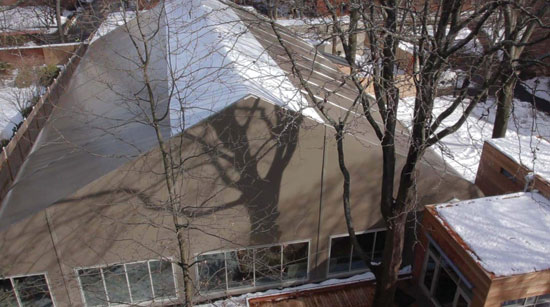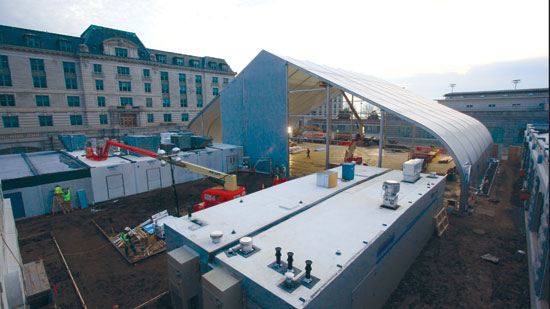Interim Executive Dining Facility Bridges Construction Gap at Business School
Staff locker rooms and wash rooms are also included in the structure. In one of the key features of the interim dining and kitchen complex, designers integrated a series of enclosed modular walkways for efficiency and ease of transitioning between task areas. “The enclosed walkways provide an enclosed protected environment for the movement of food and production staff and tie the entire modular space together,” says Ralph Goldbeck, AIA, partner at Kitchens To Go. The interface between the architectural membrane structure and the kitchen modules was given considerable attention, and has worked out to achieve open and free access visually, verbally, and physically.
During the construction process, a major concern was protecting the large, historic trees on the grounds. “It's one thing not to go through the trees but you also have to be careful of their root systems and any loads that you are imposing within these systems,” says Rob Pierce, director of Shepley Bulfinch. “We all struggled with ways to thread the facility amongst the trees.” The solution involved the installation of a series of large-scale girders that span the rootball of these large specimen trees, so as to not stress the tree.
Users call the interim facility beautiful visually and operationally, and staff note that the work areas are efficient and effective. “No one can believe it is a temporary structure,” says Todd Mulder, regional director at Restaurant Associates. “If you didn't tell people there were trailer modules back there, I don't think they would know.”
High-Performance Fabric Building Solutions Explained
The tensioned membrane structure has been around for more than three decades. Patented in the late 1970s as an alternative to existing construction methods, these permanent, habitable tension-membrane structures were first used for the oil and gas industry in both arctic and desert climes, and eventually adapted for use in virtually every market sector.

Photo courtesy of Sprung Structures
Fabric building solutions have been adapted for every market sector as can be seen in this exterior shot of a facility at Grand Canyon University.
Fabric Building—Engineered for Performance and Designed to be Relocated and Repurposed
No, a fabric structure is not a tent. It is an engineered tensioned membrane structure that is a customized solution for permanent or semi-permanent projects, and constructed of extruded aluminum arches that are integrally connected to an all-weather outer flame-retardant architectural membrane. Unlike a tent product with a short life as a temporary structure, an architectural membrane facility can serve as the basis for a habitable building for many years, and is structured to withstand high wind loads and designed to shed snow. The three building blocks of a fabric building solution are: substructure, architectural membrane, and insulation.
Substructure. While many times conventional construction relies on steel as its substructure material, a prefabricated and ready-to-assemble extruded aluminum substructure can provide greater versatility and performance. Aluminum offers several advantages over other substructure materials. It is rustproof and, unlike steel and wood, an aluminum substructure performs extremely well in humid environmental conditions. Aluminum's strength exceeds building codes and it is lightweight, about one-third the weight of steel. In terms of structural versatility, aluminum has an edge over other materials as it can be extruded into virtually any shape. Connections are bolted, not welded. Its ratio of strength-to-weight means it can provide more value for less weight—which in turn translates to easier, less expensive shipping and handling. Aluminum has an indefinite life expectancy, and has been shown to actually get stronger as it ages. Further, it is 100 percent recyclable, with no loss of quality.
Architectural membrane. Unique among construction materials, the architectural membrane affords architects the ability to enhance creative solutions using a strong, environmentally friendly, and energy-efficient product. An exterior architectural membrane can be superior in many ways to conventional types of construction, and offers one of the lightest materials on the market today and associated reductions in transportation and handling costs.
There are various types of membranes on the market.

Photo courtesy of Kitchens To Go/Sprung Structures
The architectural membrane affords architects the ability to enhance creative solutions using a strong, environmentally friendly, and energy-efficient product.
Kynar formulated PVDF resins are one of the most stable and purest of all commercial resins, and are designed for permanent or long-term applications. The technology of protective coatings was first introduced in the late 1940s and continuously developed. It has evolved through the subsequent years with technological innovation. Initial applications occurred in chemical handling due to the resin's exceptional chemical resistance, and subsequently in other protective uses such as wire insulation, and ultimately in building protection due to its environmental durability.










